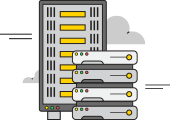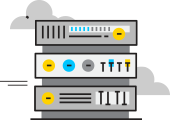A Network processor is a specialized integrated circuit (IC) or microchip designed to handle and accelerate networking tasks efficiently. It offloads the processing burden from the main central processing unit (CPU), allowing the latter to focus on general-purpose tasks. Network processors are crucial components in modern networking equipment, such as routers, switches, and firewalls, as they significantly enhance network performance and manage complex networking protocols.
The history of the origin of Network processor and the first mention of it.
The concept of network processors originated in the late 1990s when the demand for high-speed networking equipment began to surge due to the exponential growth of the internet. As network traffic continued to increase, traditional general-purpose CPUs proved insufficient to handle the massive data streams and complicated packet processing required for routing, forwarding, and security functions.
The first mention of a network processor dates back to 1997 when Intel introduced the Intel IXP1200 network processor. This early network processor paved the way for future developments in the field and demonstrated the potential of dedicated processors for networking tasks.
Detailed information about Network processor. Expanding the topic Network processor.
A Network processor is a highly specialized semiconductor component that is designed to accelerate packet processing and routing tasks in networking devices. It operates at the data link layer (Layer 2) and network layer (Layer 3) of the OSI model, efficiently managing packet forwarding, Quality of Service (QoS) policies, and security functions. Network processors can process packets at wire speed, meaning they can handle data at the same rate as the incoming data flow, ensuring smooth and uninterrupted network performance.
Key functions of a Network processor include:
-
Packet Parsing: Network processors dissect incoming data packets to extract relevant information like source and destination addresses, payload data, and protocol type.
-
Packet Classification: They determine how each packet should be handled based on pre-defined rules, such as forwarding, filtering, or dropping.
-
Traffic Management: Network processors implement QoS policies to prioritize certain types of traffic over others, ensuring optimal network performance.
-
Security: They support various security features, including virtual private networks (VPNs), firewall filtering, and intrusion detection, enhancing network security.
-
Multicast Support: Network processors enable efficient multicast packet replication and distribution to multiple recipients.
-
Header Modification: They can modify packet headers to facilitate NAT (Network Address Translation) and other network services.
The internal structure of the Network processor. How the Network processor works.
The internal structure of a Network processor comprises several key components that work together to execute networking tasks efficiently. Some of the essential components include:
-
Packet Buffers: These are memory elements used to store incoming and outgoing packets temporarily. High-speed packet buffers ensure smooth packet flow and prevent data loss.
-
Processing Cores: Network processors integrate one or more processing cores, such as CPUs, Digital Signal Processors (DSPs), or custom-designed cores optimized for packet processing tasks.
-
Memory Interface: The memory interface connects the processor to external memory, enabling access to look-up tables, routing tables, and other critical data structures.
-
Hardware Accelerators: Dedicated hardware accelerators assist in computationally intensive tasks like encryption, decryption, and compression, increasing overall processing speed.
-
Input/Output Interfaces: These interfaces facilitate connectivity with network interfaces, such as Ethernet ports and optical transceivers.
-
Control Unit: The control unit manages the overall operation of the Network processor, orchestrating the flow of data and ensuring proper task execution.
When a data packet enters the Network processor, it undergoes the following general steps:
-
Packet Reception: The Network processor receives the incoming packet from the network interface and stores it in the packet buffer.
-
Packet Parsing: The processor dissects the packet header to extract relevant information, such as source and destination addresses and packet type.
-
Packet Classification: Based on pre-defined rules and policies, the packet is classified to determine the appropriate actions, such as forwarding, filtering, or applying QoS policies.
-
Packet Processing: The Network processor performs any necessary packet modifications, such as header rewriting, payload encryption/decryption, or NAT translation.
-
Packet Forwarding: Once processing is complete, the packet is forwarded to the appropriate outgoing interface for further transmission.
Analysis of the key features of Network processor.
Network processors come with several key features that make them indispensable for modern networking equipment:
-
High Throughput: Network processors can handle data at wire speed, ensuring minimal latency and high throughput for critical networking tasks.
-
Flexibility: These processors are programmable and can adapt to different networking protocols and standards, making them suitable for a wide range of applications.
-
Scalability: Network processors can be scaled up or down based on the requirements of the networking device, allowing manufacturers to tailor their solutions to specific needs.
-
Security Enhancements: With hardware support for encryption and decryption, network processors bolster network security by efficiently handling cryptographic tasks.
-
Traffic Management: Advanced QoS capabilities enable network administrators to prioritize and manage traffic effectively, ensuring smooth data flow even during congestion.
-
Integration: Network processors often integrate various interfaces and hardware accelerators, reducing the overall complexity and cost of networking equipment.
Types of Network processor
Network processors come in different types, catering to specific networking requirements. The following table outlines the primary types of Network processors:
| Type | Description |
|---|---|
| General-Purpose NPs | Versatile processors with programmable cores for diverse networking applications. |
| Content Processing NPs | Specialized processors optimized for handling content-based services, like Deep Packet Inspection (DPI) and caching. |
| Security NPs | Focused on accelerating security functions, such as encryption, decryption, and VPN handling. |
| Flow Processors | Specifically designed to manage the flow of packets, ideal for traffic management and QoS. |
| Classification Processors | Specialized in fast and efficient packet classification, essential for firewall and filtering tasks. |
Ways to use Network processor:
-
Routers: Network processors are integral components in routers, enabling efficient packet forwarding, routing, and implementing various networking protocols.
-
Switches: They enhance switch performance by handling packet processing tasks and ensuring optimal data flow across the network.
-
Firewalls: Network processors accelerate firewall functions like packet filtering, intrusion detection, and VPN processing, enhancing network security.
-
Load Balancers: Load balancers utilize network processors to distribute incoming traffic across multiple servers, optimizing resource utilization.
-
Application Delivery Controllers (ADCs): ADCs leverage network processors to manage application traffic, providing faster and more reliable delivery of applications.
Problems and Solutions:
-
Scalability: As network traffic continues to grow, scalability becomes a concern. Manufacturers can address this by using more powerful and flexible Network processors capable of handling increasing data rates.
-
Security Vulnerabilities: With the rise in cyber threats, network processors must implement robust security features and hardware acceleration for encryption and decryption to protect sensitive data.
-
Packet Loss: Insufficient packet buffering can lead to packet loss during periods of high network congestion. Designing Network processors with larger packet buffers can mitigate this issue.
-
Power Consumption: Network processors can be power-hungry due to the complex tasks they handle. Developers should focus on optimizing power efficiency to reduce operational costs.
Main characteristics and other comparisons with similar terms in the form of tables and lists.
Characteristics of Network Processors:
- Specialized hardware for packet processing and networking tasks.
- High throughput and wire-speed packet handling.
- Programmable and adaptable to various networking protocols.
- Hardware acceleration for encryption, decryption, and other security functions.
- Integration of interfaces and hardware accelerators for improved efficiency.
- Scalability to cater to different networking equipment needs.
Comparison with Similar Terms:
| Term | Description |
|---|---|
| Network Processor | Specialized IC for packet processing in networking equipment. |
| CPU | General-purpose processor for executing a wide range of tasks in computing devices. |
| ASIC | Application-Specific Integrated Circuit designed for a particular function or task. |
| FPGA | Field-Programmable Gate Array, a reconfigurable hardware for diverse applications. |
| Switch ASIC | ASIC optimized for switching tasks in network switches. |
The future of Network processors holds exciting possibilities, driven by technological advancements and the increasing demands of modern networks:
-
Higher Speeds: Network processors will continue to evolve to support even higher data rates, enabling seamless connectivity for upcoming technologies like 5G and beyond.
-
AI Integration: Integration of Artificial Intelligence (AI) and machine learning in Network processors will enhance packet analysis and security threat detection.
-
Hardware-Software Co-design: The co-design of specialized hardware and software will further optimize performance and energy efficiency in Network processors.
-
Edge Computing: As edge computing gains prominence, Network processors will play a critical role in providing real-time processing and reduced latency at the network edge.
-
Security Advancements: Network processors will continually improve security features to combat evolving cyber threats and safeguard sensitive data.
How proxy servers can be used or associated with Network processor.
Proxy servers and Network processors can work hand in hand to enhance network performance and security. Proxy servers act as intermediaries between client devices and the internet, forwarding requests and responses on behalf of the clients. When integrated with Network processors, the benefits include:
-
Caching: Network processors can accelerate caching in proxy servers, storing frequently accessed data closer to clients and reducing latency.
-
Content Filtering: Network processors can efficiently process content filtering rules in proxy servers, ensuring safe and secure internet access for clients.
-
Load Balancing: By offloading packet processing tasks to Network processors, proxy servers can focus on load balancing and efficiently distributing client requests.
-
VPN Handling: Network processors can accelerate VPN processing in proxy servers, enhancing privacy and security for users accessing the internet through the proxy.
Related links
For further information about Network processors, you can explore the following links:
With the ever-increasing demands of modern networks, Network processors continue to be at the forefront of innovation, powering the backbone of our digital world. Their efficiency, scalability, and versatility make them indispensable components for networking equipment, ensuring seamless data flow, improved security, and a promising future for networking technologies.




